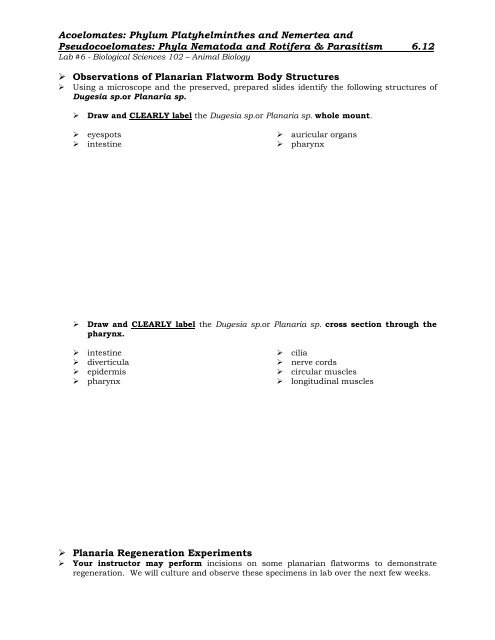Acoelomates: Phylum Platyhelminthes and Nemertea - Biosciweb.net
Acoelomates: Phylum Platyhelminthes and Nemertea - Biosciweb.net Acoelomates: Phylum Platyhelminthes and Nemertea - Biosciweb.net
Acoelomates: Phylum Platyhelminthes and Nemertea and Pseudocoelomates: Phyla Nematoda and Rotifera & Parasitism 6.12 Lab #6 - Biological Sciences 102 – Animal Biology ‣ Observations of Planarian Flatworm Body Structures ‣ Using a microscope and the preserved, prepared slides identify the following structures of Dugesia sp.or Planaria sp. ‣ Draw and CLEARLY label the Dugesia sp.or Planaria sp. whole mount. ‣ eyespots ‣ intestine ‣ auricular organs ‣ pharynx ‣ Draw and CLEARLY label the Dugesia sp.or Planaria sp. cross section through the pharynx. ‣ intestine ‣ diverticula ‣ epidermis ‣ pharynx ‣ cilia ‣ nerve cords ‣ circular muscles ‣ longitudinal muscles ‣ Planaria Regeneration Experiments ‣ Your instructor may perform incisions on some planarian flatworms to demonstrate regeneration. We will culture and observe these specimens in lab over the next few weeks.
Acoelomates: Phylum Platyhelminthes and Nemertea and Pseudocoelomates: Phyla Nematoda and Rotifera & Parasitism 6.13 Lab #6 - Biological Sciences 102 – Animal Biology Phylum Platyhelminthes Class Trematoda = flukes ‣ Observe the specimens and/or diagrams of the species listed below. ‣ Record the descriptive information requested at the end of the lab for this species. ‣ Opisthorchis (Clonorchis ) sinensis = human liver fluke ‣ Observations of Trematode Body Structures ‣ Using a microscope and the preserved, prepared slides identify the following structures of trematodes. ‣ Draw and CLEARLY label the Opisthorchis (Clonorchis) sinensis. whole mount. ‣ oral sucker ‣ ventral sucker ‣ pharynx & intestines ‣ excretory canals/ducts ‣ uterus ‣ ovary (as visible) ‣ yolk gland (as visible) ‣ anterior & posterior testes ‣ vas deferens (as visible) ‣ seminal receptacle (as visible) ‣ bladder ‣ Why do you think this species lacks a complete gut (it has only one opening, not really an anus)? ‣ Then why is a gut/intestine present at all?
- Page 1 and 2: Acoelomates: Phylum Platyhelminthes
- Page 3 and 4: Acoelomates: Phylum Platyhelminthes
- Page 5 and 6: Acoelomates: Phylum Platyhelminthes
- Page 7 and 8: Acoelomates: Phylum Platyhelminthes
- Page 9 and 10: Acoelomates: Phylum Platyhelminthes
- Page 11: Acoelomates: Phylum Platyhelminthes
- Page 15 and 16: Acoelomates: Phylum Platyhelminthes
- Page 17 and 18: Acoelomates: Phylum Platyhelminthes
- Page 19 and 20: Acoelomates: Phylum Platyhelminthes
- Page 21 and 22: Acoelomates: Phylum Platyhelminthes
- Page 23 and 24: Acoelomates: Phylum Platyhelminthes
- Page 25 and 26: Acoelomates: Phylum Platyhelminthes
<strong>Acoelomates</strong>: <strong>Phylum</strong> <strong>Platyhelminthes</strong> <strong>and</strong> <strong>Nemertea</strong> <strong>and</strong><br />
Pseudocoelomates: Phyla Nematoda <strong>and</strong> Rotifera & Parasitism 6.12<br />
Lab #6 - Biological Sciences 102 – Animal Biology<br />
‣ Observations of Planarian Flatworm Body Structures<br />
‣ Using a microscope <strong>and</strong> the preserved, prepared slides identify the following structures of<br />
Dugesia sp.or Planaria sp.<br />
‣ Draw <strong>and</strong> CLEARLY label the Dugesia sp.or Planaria sp. whole mount.<br />
‣ eyespots<br />
‣ intestine<br />
‣ auricular organs<br />
‣ pharynx<br />
‣ Draw <strong>and</strong> CLEARLY label the Dugesia sp.or Planaria sp. cross section through the<br />
pharynx.<br />
‣ intestine<br />
‣ diverticula<br />
‣ epidermis<br />
‣ pharynx<br />
‣ cilia<br />
‣ nerve cords<br />
‣ circular muscles<br />
‣ longitudinal muscles<br />
‣ Planaria Regeneration Experiments<br />
‣ Your instructor may perform incisions on some planarian flatworms to demonstrate<br />
regeneration. We will culture <strong>and</strong> observe these specimens in lab over the next few weeks.



